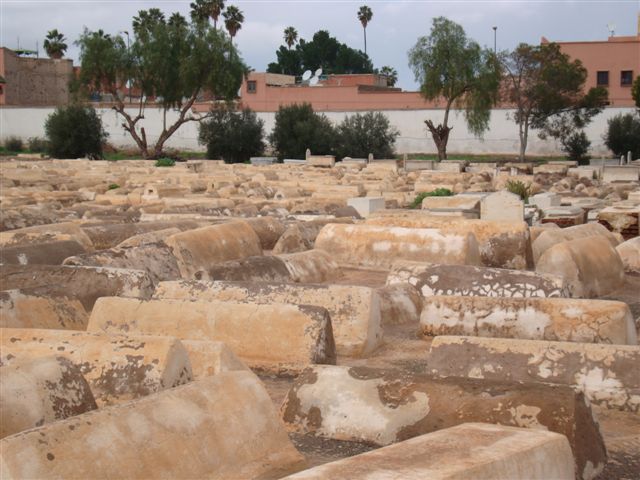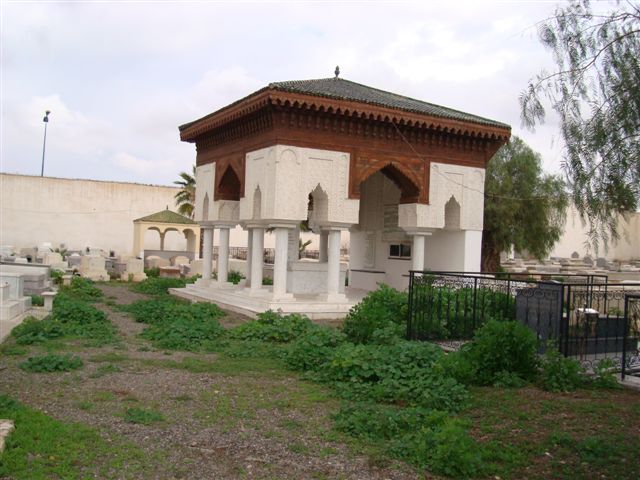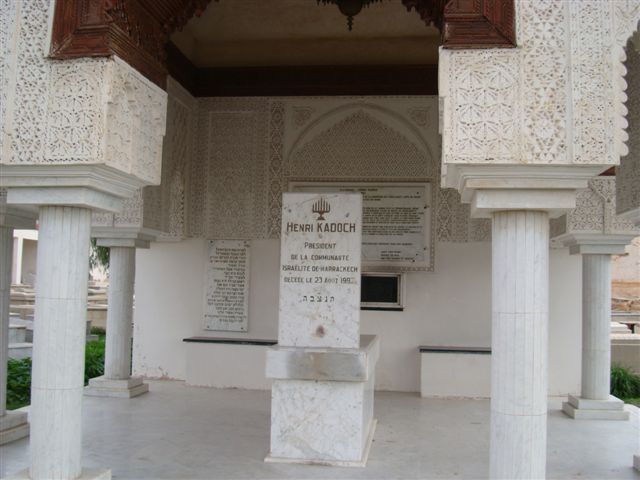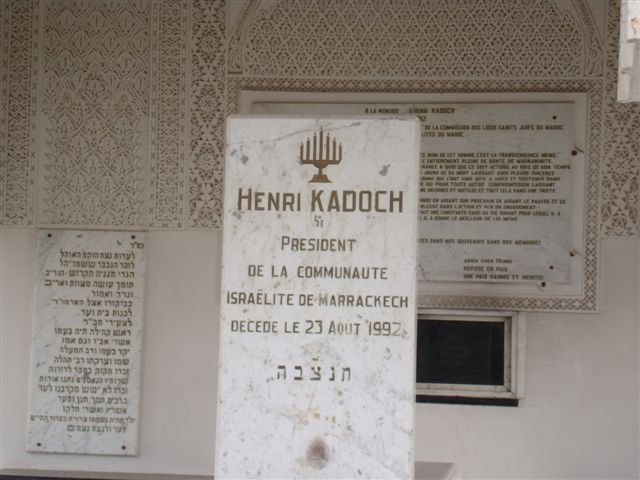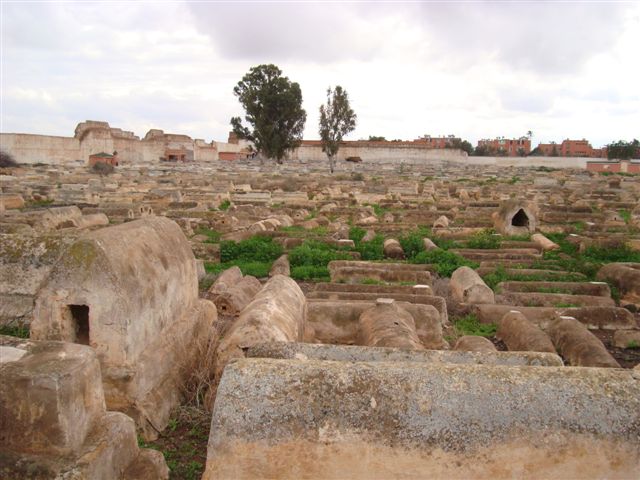The third largest city in Morocco, situated inland in the southeast of the country. It has the largest Jewish cemetery in Morocco, located adjacent to the mellah (Jewish quarter), within the medina (old city) of Marrakech and simply is called the Jewish Cemetery. Present Marrakech population is over 700,000 with a current Jewish population of about 220-250 adults and older children, plus some young children.
A local Arab family lives in a small house within the cemetery and provides ongoing maintenance of the grounds and graves--including clearing brush, whitewashing the tombstones, restoring damaged stones, and guarding the entryway. Two brothers, aged about 30 or 35, who belong to this Arab family, provided all the data for this survey, primarily in French. Their father maintained the cemetery before them. The length of time this family has cared for the site is unknown. The family is paid by the local Jewish community, at a rate of 200 dirhams per month (about $20 U.S.) for all services. The two brothers were friendly, open, and pleased to provide information. They seemed to care about the cemetery and its preservation. There were some language difficulties during the two-hour cemetery tour and interview because the brothers speak very little English, and the interviewer speaks limited French. Only information that was clearly understood is included in this write-up. The Jewish community in Marrakech was originally known as Hevra Kadisha. Individual Jews have lived in what is now Marrakech since the time of the Phoenicians, and a Jewish community has existed since at least the time of the Spanish Inquisition. The Jewish population before WWII was more than 40,000, but the vast majority has moved to Israel. The original cemetery on this site, several centuries old, is now below ground-level, completely covered, and hidden by a second "generation" (level) of graves. The current cemetery, at ground level, dates back about 200 to 300 years. Though the cemetery is still in use, it is extremely full and has only one small area remaining for future burials. There are no divisions for Orthodox or other branches Judaism, but only for Jewish burials. The cemetery is geographically near the former and current synagogues within the mellah. (Another synagogue exists in the new part of Marrakech.) Although not considered a public landmark, the cemetery is a destination for some tourists.
The cemetery location is urban, on flat land, adjacent to an Islamic cemetery, but separated from it by part of the ancient city wall. Over the cemetery doorway (a large gate in the surrounding wall) is a tiled marker sign, containing a Hebrew phrase and the date 5297 / 1537. The cemetery is reached via public streets within the mellah. However, the cemetery is accessible only to Jews and tourists (including Christians seeking Jewish ancestors). The doorway, which closes securely, is guarded by a member of the caretaker family, who asks visitors who they are and why they are there. Genealogy is an acceptable reason. Photos are allowed without restriction.
This extensive cemetery is fully surrounded by walls. The brothers claimed the walls are about 700 meters per side or 2800 meters all around; this seems unlikely and may reflect a language misunderstanding. Part of the wall is the original city rampart, built in the 12th century. The walls are about 12-15 feet tall and built of perhaps stone or brick, covered with an adobe-like, white coating. The site previously had two doors--one for Cohanim and one for everyone else. The Cohanim door has been closed for some time. The single remaining door is diligently guarded. The exact size is unknown. On the original, hidden level, the number of graves is impossible to know. On the current ground level, the brothers say about 10,000. The graves are assumedly in their original locations; the brothers did not imply otherwise. The stones are packed so tightly that no room remains for moving anything.
Few of the tombstones are toppled, because they are predominantly horizontal in style and position (see description of shapes and time periods, below). Most of the oldest markers are in good condition, because they are small and compact and get whitewashed 1 or 2 times per year. Perhaps 10% of these need major restoration due to crumbling, which reveals their brick interiors. Of the middle-aged markers, perhaps half are intact and half in need of minor or major restoration. The newer (20th-century) markers are OK.
The spaces between graves include some concrete paths, some dirt paths, some areas of low brambles. Most of the markers are extremely close together. There are few trees and no real grass. Overgrowth probably exists year-round, but probably doesn't prevent access to graves if visitors are willing to tramp through some weeds. The weeds do not seem tall or dense enough to damage the gravestones.
The climate is warm-to-hot and dry. The annual rainy season (winter) is not normally severe enough to cause problems. Previously three wells existed on the site, but all were filled-in sometime in the past when the municipality of Marrakech wanted the water supply for residential use. The dirt and cement pathways are routinely maintained and appeared fairly flat and smooth. The cemetery has three sections: for men, women, and young children. There are no divisions for Cohanim, or for married versus unmarried people. Older children apparently are buried in the men's and women's sections. The brothers said many children in the cemetery had died of cholera, or more recently of general lack of medical care. The tombstones can be differentiated by their ages, their shapes and sizes, the construction materials used, the presence and language of any inscriptions, and the presence of embedded plaques (see below).
The tombstones belong to three general time periods. Differing styles and materials were used during each period: A. The oldest stones are 200-300 years old. They are low, compact, and plain: about 4 feet long, 1 or 2 feet wide, one or two feet tall, many with lengthwise peaked tops, and without decorations or inscriptions. They're built of reddish-brown, flat bricks, covered with a thick, stucco-like coating of a limestone-sand-water mixture, and whitewashed. B. The middle-aged stones are 150-200 years old. They are coffin-shaped, about 6 feet long, 2 feet wide, two or three feet tall, with flat tops. Some are made of stone, either coated with limestone or uncoated. Others are made of "mosaic" (the Arab brothers' term), meaning white cement mixed with tiny shards of multi-hued graphite, with a smooth, uncoated surface. Many middle-aged tombs have relief inscriptions; some have embedded plaques instead (see definition below). C. The newest stones are less than 150 years old. They are coffin-shaped like the middle-aged tombstones, but are slightly larger, and constructed mostly of marble, with carved inscriptions. The stones in categories A, B, and C are all essentially horizontal. The only vertical gravestones in this cemetery are several room-sized monuments belonging to rich families or rabbis. Inscriptions and plaques: The brothers have no paper listing of people buried in Marrakech's Jewish cemetery. Identifying the people buried under the oldest, plain horizontal markers is impossible. Among the 150-200-year-old markers, many bear relief inscriptions in their rock or limestone top surfaces. Other middle-aged graves, owned by poor families who couldn't afford inscriptions, have a flat, irregularly-shaped piece of glazed pottery or stone or other hard material embedded into the top or side surface. An embedded object may be plain, decorated (e.g., with a floral design), inscribed with words, or have any other color or structure. The purpose: so survivors could identify the otherwise-generic grave of their loved one by finding the tomb carrying the correct plaque. There are many such plaques in this cemetery. The newer graves contain standard inscriptions carved into marble tops.
Most inscriptions are in Hebrew. French appears on the newer stones. The oldest graves (200-300 years-in some cases maybe even older) have no inscriptions. The graves with embedded objects are about 200 years old. The graves with Hebrew relief inscriptions are less than 200 years old.
The graves with Hebrew or French carved inscriptions are mostly from the 20th century. The method of inscribing the date also reveals a grave's age: older stones use Hebrew letters to represent the date; later stones state the Jewish year (5706, etc.); modern stones state the secular year (1960, etc.). There is considerable overlap in the use of these methods. But overall, except for 20th-century graves, the vast majority of stones do not identify the deceased. The two brothers who care for the cemetery read Hebrew and can translate into French the details of tomb inscriptions. They also understand Jewish customs regarding names and dates on tombstones, and know general information about Judaism, although they and their family are Muslim.
There are no special memorial monuments to Holocaust victims or other groups. The only unusual graves are family monuments for half a dozen wealthy families or rabbis, including one for the recently deceased president of the Jewish community.
The local Jewish community supports the cemetery. Actual ownership of the land was not stated. The site is still reserved exclusively for Jewish burials. No other burials or uses are allowed. Adjacent properties include a large Islamic cemetery on the other side of the oldest wall, the mellah beyond the opposite wall, and medina streets and shops beyond the other walls. The size of the cemetery is probably not significantly different now than in1939, though no actual comparison was made. Tourists (Jewish and Christian) from around the world (especially North America and Europe), who have ancestors buried there, visit frequently. In particular, groups of Moroccan Jews, who emigrated to Israel, used to come at the rate of two or three groups each day. However, during political crises, the number of visitors drops drastically--including during Israeli/Palestinian crises and the current war in Afghanistan; the number of visitors is very low now. Local Jews visit frequently, especially during holidays, including Rosh Khodesh.
People visiting loved ones' graves show remembrance and respect for the deceased according to their Ashkenazic or Sephardic customs. Ashkenazim place pebbles or small stones on top of the grave. Sephardim light candles, often placing a candle in a recessed portion of the grave or in a small adobe tunnel adjacent to the grave. Whether vandalism was a problem in the past is uncertain. Vandalism is not a problem now, because the caretaker family guards the cemetery at all times, questions people who want to enter, and allows in only Jews and tourists. The brothers and their family tend the grounds, whitewash the older stones one or two times per year, guard the cemetery entrance, talk with visitors, and perform restoration work themselves. Since not much money is available for marker restoration, the brothers often restore at the specific request of descendants of a deceased person buried in the cemetery; the descendants provide money for the repairs. The brothers receive some labor assistance from persons outside the caretaker family--necessary since the cemetery is so large. They seem interested in caring for and protecting the cemetery, despite financial limitations. Overall, the cemetery appears unpolished and worn, but stable and respectful. The Arab brothers do restoration work locally. Whether any support money is received from overseas is unknown. The work is done as needed and as money becomes available. Many graves still need restoration work.
The local Jewish community pays the caretaker family at the rate of 200 dirhams ($20 U.S.) per month. The brothers say this is insufficient to support their family and pay for the needed restorations; this is probably true. No admission fee is required to enter the cemetery, though a Jewish man at the door requests donations from exiting visitors. The brothers will accept donations for their support or for restoration costs. Structures within the cemetery include the caretaker family's small house, plus several room-sized monuments. The only moderate threat is lack of sufficient funds for ongoing restoration needs. The Marrakech Jewish Cemetery is not notably endangered by weather or vandals, but rather by a lack of money to keep up with the restoration of tombstones. The Jewish community in Marrakech is tiny, and the mellah area is far from wealthy. People from overseas may or may not be supporting the synagogue, but apparently not much money comes to the cemetery. The biggest enemy is time, which is eroding the graves quicker than funds are arriving to fix them."
This email address is being protected from spambots. You need JavaScript enabled to view it. completed this survey and visited site on 2 November 2001. All information given in this survey was received verbally from the two brothers belonging to the caretaker family. Other documentation: unknown. She interviewed the caretaker brothers say no list exists of people buried in the cemetery. The Jewish community in Marrakech possibly has a list of 20th-century burials. She spent about two hours walking in the cemetery, photographing graves, and talking with the caretaker brothers. In addition, several days later she toured the mellah with a local man, and saw the markets and lanes, the old synagogue doorway, the place where food is made kosher, the walled entryway to the current mellah synagogue, and the inside of the synagogue itself. [December 2001]
"The Marrakesh mellah dates from the 1550's, as noted on the door to the Jewish cemetery. ... The Marrakesh cemetery is the site of the Jewish saint Hanania Cohen. ...The rural areas surrounding Marrakesh have the heaviest concentration of Jewish saints of anywhere in Morocco. Demnate, northeast of Marrakesh, is one of the few rural towns with a well-developed mellah, as well as a cemetery with the saint David Draa Halevy. Near-by Sidi Rahal has the mausoleum of Jacob Ashkenazi, called Moul Lma (Lord of the Water), since it is built over a stream. South of Marrakesh, in the ancient town of Aghbalou in the Ourika Valley, the tomb of Saloman ben Elhans is cared for by one of the few remaining Berber Jews in Morocco. At the highest point on the road to Ouarzazate, a Jewish saint, David Lachkar (or Moulay Ighi), is buried in the stronghold of the most powerful Berber family of the twentieth century, the Glaoui." Source [February 2002]
Update: An embedded object may be plain, decorated (e.g., with a floral design), inscribed with words, or have any other color or structure. The purpose: so survivors could identify the otherwise-generic grave of their loved one by finding the tomb carrying the correct plaque. There are many such plaques in this cemetery. The newer graves contain standard inscriptions carved into marble tops.
Most inscriptions are in Hebrew. French appears on the newer stones. The graves with embedded objects are about 200 years old. The graves with Hebrew relief inscriptions are less than 200 years old.
The graves with Hebrew or French carved inscriptions are mostly from the 20th century. The method of inscribing the date also reveals a grave's age: older stones use Hebrew letters to represent the date; later stones state the Jewish year (5706, etc.); modern stones state the secular year (1960, etc.). There is considerable overlap in the use of these methods. But overall, except for 20th-century graves, the vast majority of stones do not identify the deceased. Vandalism is a problem . The mellah is a dangerous area specially at night.
Unlike the Moslem old city or medina, the mellah has many three story buildings towering over narrow streets, reflecting the crowded conditions of the many Jews who lived there until the 1960's. In the Jewish quarter there are synagogues and schools and a Jewish cemetery where Rabbi Hanania Ha-Cohen, the Lion of Marrakesh is buried. Also buried here is Rabbi Pinchas Cohenish. The cemetery is not notably endangered by weather or vandals, but rather by a lack of money to keep up with the restoration of tombstones. Photos below courtesy This email address is being protected from spambots. You need JavaScript enabled to view it. [February 2010]


